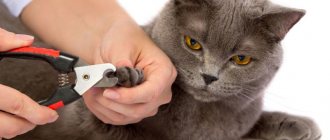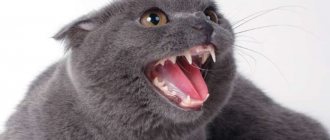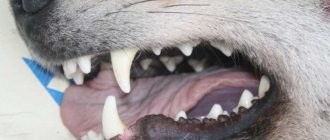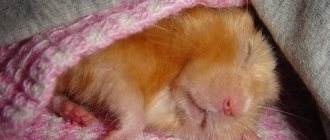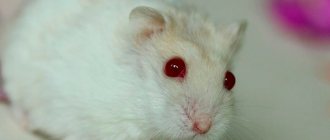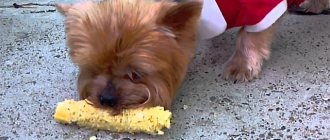- home
- General information
13.04.2018
A hamster's teeth are an indicator of its health. Owners should monitor their pet's teeth. If everything is not okay with them, the animal will not be able to eat normally. And proper and nutritious nutrition is important for all living beings.
How many teeth does a hamster have?
If you look at the animal’s face, it seems that it has only two long incisors in its mouth. But this is a misconception. The hamster has 16 teeth: two incisors and six molars on the upper jaw, the same number on the lower jaw. The animal chews solid food with its incisors, and grinds it with its molars. The rodent's thick cheeks make it difficult to see the entire dentition. To examine the teeth growing in the depths of the oral cavity, you need to take the hamster by the scruff of the neck with your fingers and pull the cheeks back. Then the jaws will be almost completely exposed.
Djungarian hamster: features of communication with the animal
The Djungarian hamster, the photo of which is presented below, is a cute and harmless animal. But this little family member also has his own character and behavior. Here's what you need to know when establishing communication with Djungarians:
Relationships with relatives
Djungarian hamsters live alone in nature. If you want to get offspring, then take two rodents from the same litter. Even in this case, they may not get along with each other, and then battles are guaranteed. Dzungariks defend their territory aggressively and assertively, so they fight until there is blood. Keep this in mind if you decide to add a Djungarian or Syrian neighbor to your rodent.
If the female is expecting offspring, move the male to a separate “apartment”. Pregnancy is stressful for both parents, so one of them will definitely eat the offspring.
Photo: pixabay.com: UGC
Djungarian hamster in the same territory with dogs and cats
The presence of a larger predator next to the cage will in no way disrupt the peaceful course of life of the rodent. A smart dwarf will quickly understand that the bars of his cage protect him from the claws and teeth of a cat or dog and will stop paying attention to their attempts to pull him out of the cage. He will also run quickly, rummage through sawdust, and carry grains. Sometimes it will do this on purpose to tease predators.
The danger lies in the hamster's curiosity and energy, which force him to leave the cage at the earliest opportunity. Then his life is in danger. So remember to close the cage, play and train your hamster, making sure there are no other animals in the room.
Communication between a dzhungarik and a person
The smart and funny hamster is easy to tame. He will happily leave the cage to run and frolic in a small space. Rodents react well to children, do not bite, but always try to escape. Since they are fragile and delicate, during play, make sure that the hamster does not get injured by falling from a height or getting stuck between two objects.
Photo: pixabay.com: UGC
To minimize the stress of taming a dwarf:
- In the first week of life in a new place, allow the rodent to adapt. Place the cage so that he can observe people's movements, but so that the noise is minimal.
- Do not disturb the animal during daytime sleep.
- Don't "rob" his bins.
- In the first weeks, watch his games and talk to the animal so that he gets used to the human voice and his presence.
- Lure him out of the house by offering him treats - nuts or dried fruits. After a while he will get used to eating from his hands and sitting on his palm.
Djungarian hamsters are ideal pets for small children. Children 3–4 years old enjoy caring for these animals: feeding them and helping with cleaning. Unpretentiousness and ease of care, lively character and comic actions make the Djungarians family favorites.
Why do hamsters sharpen their teeth?
Breeders know that their furry pets' incisors grow non-stop throughout their lives. Therefore, rodents are forced to constantly sharpen their gnawing tools. Why is this happening? The fact is that hamster incisors have neither roots nor nerve endings and are empty bone tissue. Therefore, the grinding process is not accompanied by pain or discomfort. To sharpen its teeth, the animal simply diligently gnaws on any hard object that catches its eye. Interestingly, the hamster’s teeth are covered with a thick layer of enamel in front, and thin in the back. This unevenness of the coating is not without reason: when sharpening, the ends of the cutters do not become dull, but become sharpened. And with its sharp teeth, the rodent easily chews any hard food. The animal's molars have to be sharpened, just like its incisors.
What the owner might notice
The first thing the owner notices is that the rodent refuses food. This is obvious, since deformed teeth do not allow him to chew food well. Drooling is possible; if the gums are damaged, the saliva turns red.
Additional symptoms:
- poor appearance, the animal is unkempt, stops caring for its fur;
- when there is a lack of food, the fur begins to droop;
- progressive exhaustion;
- growth of teeth to the outside or inside the oral cavity;
- inflammatory process of gums, lips;
- formation of abscesses during wound suppuration;
- lacrimation turning into purulent conjunctivitis;
- no bowel movement.
The entire symptom complex progresses very quickly, so even in the event of refusal of food, non-standard behavior of the rodent, or minor external changes, you need to consult a veterinarian. Slight tooth growth can be corrected by removing excess overgrowth, trimming incisors and molars. The longer the owner postpones a visit to the veterinary clinic, the higher the risk of developing irreversible consequences.
What do hamsters sharpen their teeth with?
A rodent will always find something to sharpen its incisors. If there are no pebbles or pieces of tree bark nearby, the animal begins to chew on the cage bars. To prevent the animal from suffering from gnawing metal bars, the owners need to provide the pet with special devices for sharpening its teeth. It is recommended to purchase a mineral stone for rodents and parrots at a pet store. If there is a garden near your house, you can break off several branches of fruit trees and put them in a cage. When a hamster chews on a chalk stone and tree bark, it not only wears down its incisors, but also supplies the body with a large amount of useful substances. It is important that the animal has solid cereal food in its feeder every day. An animal that eats soft foods inevitably deteriorates its teeth and deteriorates in health.
Treats
Today, the pet store can offer another option for grinding teeth - grain sticks. They come in different grain compositions with the addition of various minerals and trace elements. This delicacy will definitely please your taste! You can also prepare your hamster’s liver yourself!
cereal sticks
In addition, if you tie the treat in such a way that the hamster has to work hard to get to it, then it will also serve as good entertainment and additional physical activity for your pet.
A hamster should not chew ordinary school chalk; after all, it is non-food and is not intended for such purposes. Food products undergo several degrees of purification, so they are safe for the animal.
When does a hamster need to have its teeth trimmed?
Sometimes an animal needs urgent dental care. A rodent can accidentally knock out or break off a tooth. There is no need to worry too much: a damaged incisor quickly grows to its normal size. The problem lies elsewhere. Due to injury, the incisors grow unevenly, with one being longer than the other. With this pathology, the animal cannot eat normally or chew solid food. To prevent the hamster from starving, the incisors need to be trimmed. This is a simple procedure performed by a veterinarian. The doctor cuts off an extra piece of a longer tooth. If it is not possible to visit a veterinary clinic, you can treat your pet at home. How to trim hamster incisors correctly at home? To straighten your hamster's teeth, you need to take nail clippers or a cat's nail clipper and carefully cut off the excess part of the incisor. The animal will not feel pain if the procedure is carried out carefully.
When you need help
No normal animal lover would deny the importance of dental health for pets. If the animal does not sharpen as needed, the incisors will become crooked or overgrown.
It is important to pay attention to this, since the life of hamsters depends on it. In this case, the animal may even die from hunger. To prevent this from happening, you need to contact a veterinarian and trim it. When the length is normal, he will be able to grind them down himself. You should not shorten long incisors yourself.
How to identify dental problems in a hamster?
How can you tell if your pet’s teeth are not okay? You need to observe the rodent; its behavior is a good indicator of health.
- Increased salivation in an animal is a sure sign of tooth loss.
- If your hamster is chattering his teeth, he is irritated or angry. Usually the animal does not like being squeezed by strangers.
- If the bite is incorrect, the jaws do not close completely, the hamster feels unwell, and food remains get stuck in its cheek pouches.
- If a rodent grinds its teeth, it expresses dissatisfaction. The pet is probably in a stressful state, constantly tense and afraid.
- If an animal's incisors grow crookedly, then it eats poorly and chews food with difficulty.
Djungarian hamster: care
Hamsters are an optimal alternative to large pets - dogs, cats, birds. Small in size, they fit into compact cages that can be placed anywhere in the room. They do not need to be brushed, walked or bathed daily.
Some animal lovers may have a question: what are the benefits of a hamster? You can’t pet him, you can’t run with him (unless he escapes from the cage and you have to organize a hunt for the cunning pet), he doesn’t purr and doesn’t know how to whine cheerfully.
Some people are fascinated by the energy and activity of hamsters, the specifics of their pastime and actions. They can be comical, especially when they try to carry more in their cheek pouches than they weigh themselves.
Photo: pixabay.com: UGC
However, there are categories of people for whom even an ordinary hamster is a fairly large animal, which also has a specific aroma and multiplies exponentially. Therefore, they are looking for a miniature pet that would not emit an odor and could live without a mate. Djungarian hamsters have these qualities.
Dzhungariks are inhabitants of the steppes of Central Asia. In their natural environment, you will meet them in Eastern Kazakhstan, Khakassia and Western Siberia.
These rodents are small in size: they weigh up to 40 g and grow up to 5 cm. They have a characteristic feature - a dark stripe of fur that runs from the head to a short tail.
A photo of Djungarian hamsters demonstrates the richness of their colors. Nurseries will offer rodents: gray-blue, pearl (white) or light brown (tangerine) in color.
Photo: Wikipedia: UGC
The Djungarian hamster is an active nocturnal animal. Consider this nuance when buying a pet. If you have sensitive hearing, then refuse such a purchase. Otherwise, this cute rodent is easy to keep at home.
How to care for a Djungarian hamster? This question worries those who are getting such a pet for the first time. Here are the basic rules that we recommend following in order to create comfortable conditions for the animal, provide it with proper physical activity, nutrition and care for the dwarfs:
Which cage to choose?
Despite their small size, dwarfs are very active and love to run. Therefore, buy your pet a two- to three-story cage with iron or plastic bars (they can easily chew through wooden ones).
The cage must have a strong and reliable latch, otherwise cunning travelers will easily open the doors and escape. In this case, the rodents will have to be caught in special traps and returned to their place.
Alternatively, use a large aquarium with high walls. Never put your hamster in a jar or narrow container. The problem with glassware is the lack of air circulation. Because of this, pathogenic bacteria develop and the hamsters get sick.
How to arrange a cage?
Equip the cage with a house, a wheel and pipes. Rodents of this breed vitally need to move a lot: climb passages, spin a running wheel. If there is no such equipment, the Djungarians will quickly gain weight, because they do not know what to eat in moderation, and they will develop obesity, which will lead to death.
In addition, install a ceramic feeder in the cage (if there are two rodents, then double so that they do not fight), screw the drinking bowl to the bars of the cage.
Djungarians are clean animals; they carefully monitor the cleanliness of their fur. If it gets dirty, then put a bath in the cage with sand for chinchillas or regular sand. The hamster enjoys shopping in it.
Photo: pixabay.com: UGC
Where to put the cage?
Place the permanent habitat of the dwarfs so that it receives diffused sunlight. Place the cage away from drafts and the heating system.
How to cover the cage?
Some owners put cotton wool or torn paper (newspapers) on the bottom of the cage. This is not rational, not practical and harmful to the animal. Hamsters will have to change their bedding frequently, so buying cotton wool will be a major expense. Newspapers and papers may contain printing or printer ink. It is toxic to rodents.
Buy cellulose or corn sawdust from a pet store. They are environmentally friendly, inexpensive and easy to recycle: such litter is thrown into the sewer, in trash containers or buried in the garden.
To make a comfortable rookery (hamsters bury themselves in sawdust during the day), spread a small layer of bedding. If you need to make a den, the Djungarians will rake sawdust into a pile exactly as much as needed. Napkins are also suitable for these purposes. Their clever sneaks drag them into a house where they build a nest.
Photo: pixabay.com: UGC
How often should you deep clean your cage?
Clean dzhungarikas arrange a toilet in one of the corners of the cage. Therefore, the owners’ task is to clean this place every day.
But it cannot be confused with animal bins. If you regularly throw away the supplies of grains and fruits that a rodent makes, it will become stressed and may get sick. Remove only the storage area where food has spoiled and an unpleasant odor has appeared.
Change the rest of the bedding once a week and do general cleaning: wash the bottom of the cage, accessories, toy, bowl, drinking bowl with a sponge, laundry soap and hot water. For especially “fragrant” places, use a vinegar solution (1 tablespoon per 1 glass of water). After wiping with this composition, wash the item being treated with clean water.
It is not worth cleaning the hamster’s “apartment” more often, because for them the moments of replacing sawdust are extremely stressful. While tidying up, move the hamster into a smaller cage.
Djungarians do not live long - 2-3 years. Therefore, to maintain health and prevent diseases, they need proper living conditions and special care. Then the cheerful fidgets will delight you with fun games and interesting ideas.
How to prevent dental diseases in a hamster?
Owners should closely monitor the health of their pet. It is important to periodically inspect the animal’s jaws to prevent the occurrence of pathologies. Rodents do not like having their mouths forced open and try to break free and run away. Therefore, you will have to suffer to hold the hamster in your hands during examination. If the animal's molars are straight and its incisors are the same length, then everything is fine. To keep your hamster's teeth strong and healthy, it is advisable to buy food with calcium for your pet. If the hamster begins to behave strangely, refuses food, and splutters, then you must immediately show it to the veterinarian.
Why teeth break: will they grow back?
A healthy hamster has orange or even yellow enamel. If the enamel is white, then this is an indicator of problems in the body. If your hamster's teeth suddenly fall out, this happens in the following cases:
- Poor nutrition.
- Significant sugar content in products.
- Injury from a fall from a height.
- A fight between animals.
- Granules too hard.
If your upper or lower teeth have fallen out, then there is no need to worry. New ones will appear soon. It is necessary to monitor the length of the remaining teeth, as they may grow too quickly. Often, incisors fall out if there is not enough calcium in the animal’s body. In this case, you should introduce milk or cheese into your diet.
Oral diseases: treatment and prognosis
The problem of malocclusion will be lifelong. Therefore, the owner will have to regularly visit a specialist (every 2-6 months) and correct the dental problem. The treatment is based on filing the tooth, adjusting its height and removing “tooth hooks” on the molars.
For this, various dental devices are used, the operation is performed under general anesthesia - gas anesthesia is used, since intravenous drugs for a rodent are very difficult to dose and administer.
In an advanced state, treatment of the consequences will be required - removal of abscesses, wounds, treatment of conjunctivitis, etc. The prognosis depends on when the owner of the rodent went to the clinic, how extensive and advanced the problem is. At an early stage, correcting tooth growth completely eliminates the development of dental syndrome. Regular examination by a veterinarian is an opportunity to prolong your pet’s life and make it comfortable.
If you notice that your pet rodent is behaving unusually, is refusing food, or has become unkempt in appearance – don’t hesitate! Call the Ros-Vet VC and make an appointment with a ratologist by phone, 24 hours a day.
